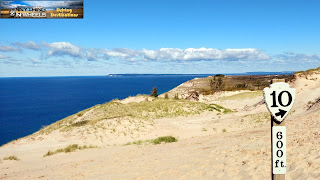Variant Driven: SX CRDi
Compact crossovers have been hot properties in the country ever since Ford's EcoSport burst into the scene in 2013. Over the years, Maruti-Suzuki, Honda, Tata and Mahindra joined the party, grabbing a slice of the ever-growing pie along the way. One biggie conspicuous by its absence in this space was Hyundai. Of course, the Korean car-maker was busy minting money and decimating rivals with the bigger Creta but that doesn't erase the fact that they missed being a part of this crucial segment all along.
In comes the new Venue, trying to make up for lost time with bold looks, plethora of features, a host of engine and transmission options and par-for-the-course pricing. Should the Brezzas and EcoSports out there be worried?
We tell you after driving a SX diesel variant for the better part of a day.
Venue gets Hyundai’s latest and boldest face
Walk up to the car and it’s tough (we mean it!) to focus on anything other than that cheese-grater of a grille. Hyundai’s trademark ‘Cascading Grille’ has become bigger, bolder and - with those ‘in-your-face’ chrome-lined horizontal and vertical slats - screams for attention. That said, it wasn't as intimidating in person as it was when we first looked at the launch images. The rest of the fascia adopts the Korean brand's latest global SUV design language with split lighting clusters that debuted in the current-generation Santa Fe before making its way onto the Kona and Palisade. Venue is the latest to get it with the Tucson next in line.

The thin lenses on top are actually the turn indicators and not Daytime Running Lights as you would've thought. The DRLs are actually positioned below with the headlights and cornering lamps while the fog lamps are placed further down in the bumper. Some might find the LED DRL signature to be too simple, but we think it gives the Venue a distinct identity when it comes up in your rear view mirror. In profile, the Venue is just a mini-Creta. Just like it's bigger sibling, the Venue gets a floating roof effect courtesy blackened A- and B-pillars with the chunky C-pillar and sharply-cut rear doors giving it an aggressive, tipped-forward stance. A strong waist line that runs the full length of the car and mildly-flared sheet metal around the wheel arches look balanced and attractive. The rear, in comparison, is too plain and gives the Venue a hatchback look and feel. The taillights, though, are wonderfully-detailed and look terrific.
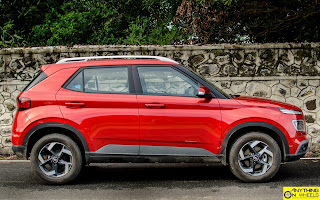
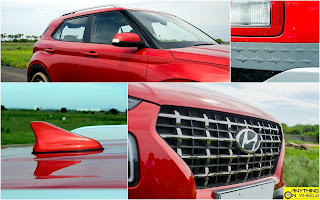
Crossovers these days masquerade as SUVs and the Venue is no different. From dual-tone front and rear bumpers with silver inserts and fake skid plates to plastic cladding running the full length of the car, Hyundai's tiny crossover gets everything you look for in SUVs. Roof rails and smartly-designed diamond-cut alloys complete the show.
Hyundai's mastery inside continues
If there is one thing the folks in Hyundai have been consistently at their best over the years, it's in the way they design and put together a new model's interiors. The Venue does no harm to that legacy.
With a layout that's smart and functional and fit and finish that's second to none in the segment (and even one above) in most places, Hyundai's Brezza-slayer scores a big impression straight away. Sat in the driver's seat, the nicely-contoured steering wheel and the well-designed center console housing those snazzy (but a tad too big) climate control buttons draw your attention. The large air-con vents exude quality and are surrounded by classy brushed silver inserts. The door pads are designed to look like a continuation of the dashboard on either side with the door handles also featuring the same brushed silver effect. The 8.0-inch touchscreen infotainment system, though, could have been integrated better.
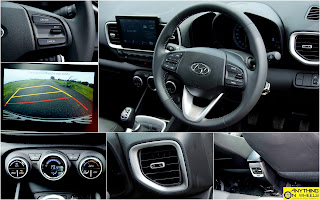
The Venue, just like any new Hyundai, comes with an extensive feature list including driver and passenger airbag, Anti-lock Braking System with Electronic Brake-force Distribution, reverse parking sensors with dynamic guidelines, cruise control, ISOFIX mounts, speed alert, automatic headlamps, leather-wrapped steering wheel and gearknob, adjustable front and rear head-rests, 8.0-inch touchscreen infotainment system, climate control and the much-loved electric sunroof. But, it does lose out on goodies like side and curtain airbags, Electronic Stability Control (ESC), Vehicle Stability Management (VSM), Hill Assist Control (HAC), supervision cluster, rear wiper, keyless entry with push button start, wireless phone charger and the Blue Link party trick that are reserved for the top-end SX(O) and SX DCT variants.
Instrument Cluster:
The SX variant tested loses out on the advanced supervision cluster, yes, but the dials in this car aren't what you would call boring. Featuring a large circular speedometer in the center with the tachometer on the left and LCD display screen on the right, the cluster looks quite interesting with checkered graphics and a pod-like surround. The screen displays all essential information including two trip meters, average fuel efficiency, instantaneous fuel efficiency, distance to empty, average speed and engine running time.
Infotainment System:
Venue's rise to fame has been the much-hyped and super-cool BlueLink platform that comes with an in-built SIM card and a host of connected features. The SX variant loses out on this but the infotainment system on-board has all the features you'll ever need.
Equipped with four speakers and two tweeters with Arkamys Sound, the system has BlueTooth connectivity, is compatible with Android Auto and Apple CarPlay and is even equipped with Voice Recognition. The 8.0-inch touchscreen is simple to use, fluid to the touch and offers an array of options to customize the car's interiors. The screen doubles up as rear parking display with adaptive guidelines when the reverse gear is engaged. The presence of physical buttons below the touchscreen for all key infotainment functions means you don't have to take your eyes off the road everytime, a thoughtful approach not all manufacturers think of.
Interior quality is top-notch, but not everywhere
As surprised as you may be reading that sub-title, Hyundai's interiors have started showing explicit signs of cost-cutting of late. We highlighted a few in the Santro but that can be excused, considering the car competes in a price-sensitive segment where every Rupee counts. Surprisingly, the Venue's cabin have a few goof-ups too!
Look at those barren door pads. Made of plastic from top to bottom with nary a soft surface or contrasting element to lay our hands or eyes on, they felt cheap. We may be wrong but even the Santro's door pads felt better. Thank goodness, the SX(O) has a leather-padded armrest. Similarly, the levers to push the backrest and adjust the seat height don't feel sturdy and long-lasting. Come on Hyundai, you have pampered us so much for so long. Why cut corners now when the image is built?
It's a crossover alright, albeit a diminutive one
Thanks to the huge success of Creta, Hyundai had a tight rope to walk while developing the Venue. Making it as big as some of it's rivals from the segment would eat into Creta's volumes big-time and the Korean car-maker, it seems, wanted a clear visual differentiation of the hierarchy. The result is a crossover that's not as big or as spacious as one would expect.
Forget the car's diminutive dimensions and negligible road presence, the cabin is where things get really congested. The front seats are wide enough and reasonably comfortable for even plus-sized adults. The rear seat, though, is a different story. The legroom is just about sufficient and not what one would call spacious. Forget the spacious Nexon and XUV3OO, the Venue is not even as spacious as an EcoSport. The seat's limited width means making three average-sized adults sit in there is difficult. Add to that the rising window-line and the all-black interiors, the cabin isn't inviting.
Bigger engine and tighter handling would have helped
The trio of engines doing duty under Venue's hood include the familiar 1.2-liter petrol and 1.4-liter diesel with the new entrant in the form of an all-new 1.0-liter turbo petrol. The car we drove was diesel-powered with an engine that's shared with the i20 and lower variants of the Verna and Creta.
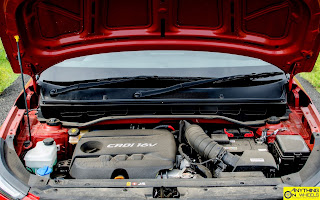
The 4-cylinder mill from the U2 family churns out 89 horsepower and 220 Nm of torque. While those numbers are far from being the best in the segment, Venue doesn't create much of a fuss to keep up with the clan. Thank the car's lesser kerb weight and the engine's minimal turbo-lag for that, with the end result being seamless power delivery in the low- and mid-range. Those are exactly what you need during those long and slow commutes within the city. The Venue doesn't disappoint out on the highway either, if you keep it in the power band. It does struggle at higher revs but then you don't buy a compact diesel crossover to rev high, do you? Mated to a 6-speed manual transmission with a light clutch and short throws, cruising is effortless and the car is quite relaxed and frugal while doing so.
If bragging rights are what you are after, wait for a few months when Hyundai is expected to plonk in a 1.5-liter diesel in the Venue. That should make this little crossover far quicker.
The Venue uses McPherson struts up front and a coupled torsion beam at the rear for suspension duties. Low speed ride quality, like all Hyundais, is compliant with the Venue making light work of the irregularities in the road. There is an underlying firmness to the ride though which makes bigger potholes and manhole covers felt sharply inside the cabin. But, that's never to the point of making the occupants uncomfortable. Handling is well-sorted too with the Venue being composed and mature all the time. Sudden lane changes are done with remarkable poise but remember, this is no EcoSport when it comes to handling. Steering feedback is just so-so despite the fact it weighs up well as speeds increase. Brakes are effective and the Venue sheds speed in a straight line without much drama upon hard braking.
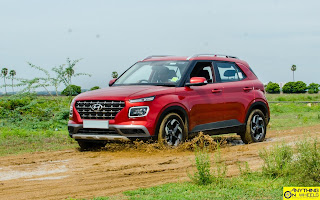
With close to 200 mm ground clearance (Hyundai hasn't published the exact figure), the Venue is tailor-made for our less-than-perfect road conditions. While it can handle those large speed-breakers at ease and that occasional off-road jaunt with some effort, don't forget this ain't an off-roader.
Specifications at a glance
Dimensions
> Length x Width x Height – 3,995 x 1,770 x 1,605 mm
> Wheelbase – 2,500 mm
> Ground Clearance – Not Available
> Fuel Tank Capacity – 45 l
Powertrain
> Configuration – I4
> Displacement – 1,396 cc
> Max. Power – 89 BHP @ 4,000 RPM
> Max. Torque – 220 Nm @ 1,500-2,750 RPM
> Transmission – 6-Speed MT
> Fuel Efficiency – 23.7 km/l
Other Hardware
> Front Suspension – McPherson Struts
> Rear Suspension – Coupled Torsion Beam Axle
> Front Brake – Disc
> Rear Brake – Drum
> Tyre Size – 215/60 R16
To sum up
At the end of its stint, the Hyundai Venue left us with a lasting impression. That's not because it was the best in one or a few aspects but because it did most things right. Hyundai's baby Creta is not as good as the EcoSport in road manners but it's not bad either. It's not as powerful or as spacious as an XUV3OO but the Venue isn't slow or cramped. The car's price tag isn't as competitive as the Nexon's but it doesn't create an impression of being overpriced. It might not have Brand Honda's pull that's helping the WR-V but Brand Hyundai is as strong, if not more. The car-buying public out there have felt the same too and that's probably why the Venue has become so successful in such a short time frame. So much so, Maruti-Suzuki's runaway best-seller Vitara Brezza is now relegated to the second spot in the sales charts.
Hyundai, then, has clearly succeeded in making up for the time lost in compact crossover space!
Text & Editing: Aravind Ramesh
Photography: Bharath Rengaraj



































